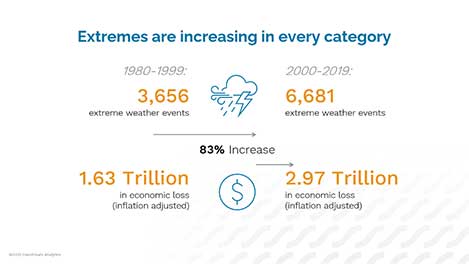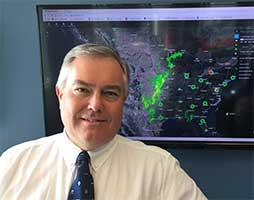Volume 26 | Issue 1
By: Jon Davis
Click here to read the complete illustrated article or continue below to read the text article.
Severe weather events have become increasingly common in recent years, from record snowfalls and extreme cold to crippling floods and punishing heat waves. These events put lives at risk, while also causing loss of jobs and property, substantial power outages, infrastructure damage and other far-reaching effects—including substantial disruptions to the supply chain, which adds to the growing economic fallout from weather disasters.

The financial costs of weather-related events have been climbing steadily each decade since the National Centers for Environmental Prediction (NCEP) started tracking billion-dollar weather disasters in 1980. In 2022 alone, there were 18 weather/climate events with losses that exceeded $1 billion, altogether totaling more than $165 billion. Although the costs from 2022 aren’t the highest on record—2017 and 2005, each with three Category 4 or 5 hurricanes, top the list—2022 still far exceeds the $116 billion average of the past five years.
Perhaps a more important factor to consider is that the frequency of weather and climate-related disasters is steadily increasing. A United Nation report notes that there have been 7,348 major weather/climate events worldwide so far this century, compared with 4,212 in the last 20 years of the 20th century. And the frequency of disasters is increasing in every category, particularly floods, storms of all kinds (not just resulting from tropical activity), extreme temperatures and drought.
The supply chain is especially vulnerable to the increased rate of weather disasters, which can cause disruptions in shipping and transportation, interruptions in business and production, and damage to infrastructure. Businesses incur capacity constraints, inventory shortages and price fluctuations, along with other consequences.
To get a feel for the supply chain impact of these events, let’s look at the three most costly weather/climate disasters of 2022—based on the most recent, complete sets of data. The most extreme weather disasters last year impacted various areas of the country, occurred throughout the year, and included a wide range of weather events. The top 3 major disruptive events included a hurricane, drought/heat, and a blast of extreme cold and historic snow during the final days of 2022.
1. Hurricane Ian
The costliest weather disaster in 2022, both in terms of fatalities and financial impact, was Hurricane Ian, which tore through the Caribbean, Florida, Georgia, and South Carolina in late September. The estimated losses totaled $112.9 billion, being felt most acutely in agriculture, as well as in tourism, manufacturing, infrastructure, and the food industry.
Ian was the third costliest event since the turn of the century, surpassed only by Hurricane Katrina (2005) and Hurricane Harvey (2017).
2. Central U.S. Heat Wave and Drought
A severe drought and heatwave plagued the western and central United States for most of 2022, peaking in late summer and fall. Damage to agriculture, livestock and industries that rely on receiving ample water supplies totaled $22.2 billion. And 136 fatalities were also attributed to the heatwave.
Although the year ended with abundant rainfall in some parts of the country, such as California, the impact of the drought is ongoing and is expected to extend well into 2023.
3. Central/Eastern U.S. Snow and Extreme Cold
The Christmas freeze and historic snowstorm impacted much of the country east of the Rockies in, and around, the Christmas Holiday. Record cold was widespread while the historic snow was limited to locations such as Buffalo, New York. These items, especially during the busy travel period, proved to be deadly as 87 fatalities were directly attributed to the extreme bout of winter weather – many of them in the Buffalo area. The financial losses from this event totaled $4.8 billion making it the 3rd most costly event of the year. The issues included more than 1 million customers without power, major travel problems, infrastructure damage, and tens of thousands of frozen water pipes and the damage to homes and businesses that occurred because of the unwanted water.
The increased frequency and mounting costs of weather and climate-related disasters has been indiscriminate, rising in virtually every category from hurricanes and winter storms to wildfires and tornados, and it isn’t going to abate. The events of the past year continue a trend that has been going on for at least four decades. Even when adjusted for inflation, the average annual economic loss from these events has grown at a staggering rate.
The trend also is global, as record heat waves in Europe and across India and Pakistan during 2022 attest. With companies increasingly relying on complex, interrelated systems of materials sourcing, manufacturing and distribution, the risks to the supply chain are increasing as well.
Severe weather events resulting from climate change or other occurrences may be outside the immediate control of companies, but how those companies react to those events can help limit the impact on their supply chains. Making use of data and powerful analytics can help organizations adapt to environmental, social and governmental (ESG) risks, including those resulting from weather and climate.
Rather than trying to fortify every link in the chain against any kind of risk, an analytics platform can use data to identify the most serious risks, and where they would have the greatest impact. In the case of weather-related events anywhere in the world, analytics can produce risk scores for Tier 1 suppliers on down the chain or into locations in another country. This can help organizations prioritize risks and take proactive measures, such as boosting inventory at one location or adding secondary supply sources.
One example involves a retailer with an international network that had a large number of stores in the path of Hurricane Ian. An Everstream Analytics team had been keeping an eye on the wind patterns in the Atlantic Ocean that would become Ian, beginning nine days before its eventual landfall, and alerted the company of the impending crisis. From locations in the United States and Europe, the team began alerting clients around the globe about the risk factors to the supply chain, both upstream and downstream.
The team also turned its attention to the store locations in Florida, assessing the storm’s models to determine how best to help the stores prepare—for instance, delivering sandbags where flooding was a particular risk, and boarding windows where high winds were expected. By making use of analytics, the retailer had the advance warning and risk analysis it needed to take proactive steps to protect multiple locations in the storm’s path.
Weather- and climate-related crises are inevitable for at least the foreseeable future. Analytics can’t prevent weather events, of course, but it can break down the strategic and operational risks and dynamically deliver insights that can help organizations predict and proactively respond to near-term risks, ultimately giving those companies a competitive advantage.

About Jon Davis:
Jon leads Everstream Analytics forecasting operations for energy, agriculture, and supply chain logistics. Based in Barcelona, Spain Jon brings over 35 years of experience and is widely considered one of the foremost experts on the impact of weather and climate on global commodities.
Scott Ellyson, CEO of East West Manufacturing, brings decades of global manufacturing and supply chain leadership to the conversation. In this episode, he shares practical insights on scaling operations, navigating complexity, and building resilient manufacturing networks in an increasingly connected world.